Our tour guide said that Bergen, a port city on the west coast of Norway, has attracted outsiders for centuries, both as traders and settlers.
Then she made the point with her own story: Although our guide was born and raised in Bergen of Norwegian forebears, she said DNA tests showed that, genetically, she has no Norwegian background at all.
The outsiders, she said, came from England and Germany or from just about anywhere in Europe to trade for stockfish, meaning wind-dried fish, generally cod.
Lots of people come to Bergen these days, too — such as tourists like me.
Bergen is a gateway to the country’s famously beautiful fjords, including the Sognefjord, Norway’s longest and deepest. Besides, Bergen’s setting on the mountainous coast is charming in its own right.
Hanseatic League
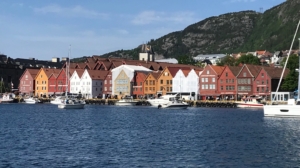
A total of 17 reconstructed Hanseatic League houses facing Bergen Harbor. The six at left were rebuilt after a 1955 fire. The 11 at right were reconstructed after a 1702 fire at a time when a few Hanseatic League personnel were still around. The 11 houses are part of the Bryggen UNESCO World Heritage Site.
The other thing is history: Beginning in the mid-14th century, Bergen was a prominent outpost of the medieval Hanseatic League, an organization of German towns that joined together to enhance and protect their trading interests. The league established overseas posts in places like Bruges, London and Novgorod, as well as Bergen.
The league took over Bryggen, the historic wharf area located on the east side of Bergen Harbor. Bryggen was where all the league’s representatives (up to 3,000 men and boys at one point) lived, worked and stashed their wares.
Today, the oldest surviving section of Bryggen is an exceedingly photogenic UNESCO World Heritage Site.
The most recognizable part of the site is a set of 11 side-by-side gabled wooden houses that front the harbor. The houses are painted in reds, browns, golds and white.
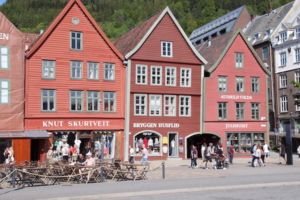
A closer look at three houses among the 11 included in the Bryggen UNESCO World Heritage Site.
The much-photographed view from the harbor is deceiving, however. Alleyways between the houses extend away from the harbor past still more wooden warehouses and residences, and lead to courtyards and a number of other small structures, including some built of stone.
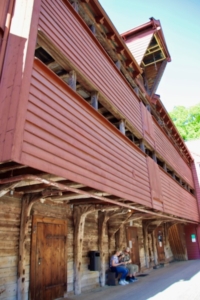
The (very) long side of one Bryggen house. Such an extended length accommodated housing for Hanseatic League personnel and storage for traded goods.

One of the stone buildings behind the more visible Bryggen houses. The league maintained a few such structures to protect records and the most valuable goods in case of fire.
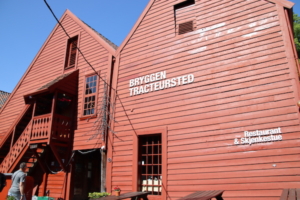
Above and below, examples of others of the less-visible Bryggen buildings that are part of the UNESCO World Heritage Site.

Four of the 11 protected buildings are undergoing major restoration to replace foundations and stem subsidence, which has threatened their viability. Shops, restaurants and other small businesses occupy spaces in the remaining houses.
Wooden cities burn down a lot. About 90% of Bergen was destroyed in the city’s worst fire, in 1702, so the Bryggen houses on UNESCO’s list are early 18th century reconstructions of the medieval originals. UNESCO says that, after Bergen’s fires, rebuilding typically followed old patterns and methods. This included rebuilding these houses atop deep wooden foundations fashioned from tree trunks and humongous interlocking slabs of wood. A sample of the standard wooden underpinnings is on display in the Bryggen courtyards.
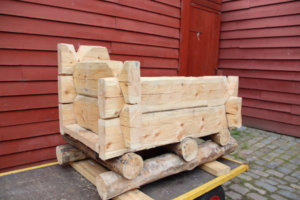
Display showing how wooden foundations were historically and continue to be built under the Bryggen houses.
Another six gabled houses, next to the UNESCO Eleven, burned in a 1955 fire. They were faithfully rebuilt to match the Hanseatic style. They, too, are filled with commercial enterprises.
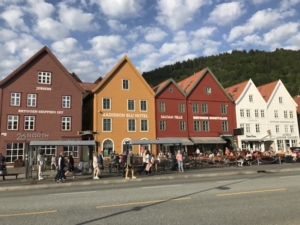
The six Bryggen houses that were faithfully reconstructed after a 1955 fire
I love looking at stuff like this, and I like it still more under sunny skies. Bergen is Europe’s rainiest city. My two previous visits were pretty good anecdotal evidence for that.
But this year (2023), my travel companion and I arrived in a Bergen under full sun; better yet, this was in June, one of the Northern Hemisphere’s longest days of the year.
So, after hotel check-in, we shot out of our room and headed to the heart of town only a few blocks away. Bergen is a city of 272,000, but a tourist’s visit is largely focused on the small and historic harbor area, the site of, besides Bryggen, a well-known fish market, a medieval fortress and a funicular that lets visitors get a sweeping view of Bergen, its harbor, mountains and more.
My friend and I walked through as much of this area as we could while jetlagged, then found outdoor seating at a pretty harbor restaurant called Olivia for a relaxing and tasty dinner, of Italian food, of all things.

Restaurants and other businesses on the innermost part of Bergen Harbor. The Italian restaurant Olivia is in the white building in the foreground.
The Mathallen
We got to the local fish the next day.
When I first visited Bergen, the city’s 700-year-old fish market operated outdoors at the innermost part of Bergen Harbor. This year, on that site, there were still a few purveyors of raw seafood, but mostly it hosted lots of seafood restaurants. Vendors also included a woman selling sausages of whale, moose and reindeer meat.
Most of the real throw-raw-fish-around fish market became a year-round operation by moving, in 2012, into a new harborside building called Mathallen (meaning Food Hall). It sits diagonally across Bergen Harbor from the UNESCO houses. The food hall has a restaurant as well, so my pal and I had a fish sandwich lunch there, likely the freshest fish I’ve ever had.
The Mathallen interior is sleek, bright, functional — but I did not like the modern exterior, which seemed out of place in this historic area. At first glance, I thought I was seeing a temporary structure. Anyway, I was so uninterested in it that my hundreds of Bergen photos include zero of Mathallen. I seldom come home with zero photos of anything.
Bergenhus Fortress
I was eager to revisit Bergenhus Fortress, which includes two very attractive lures, Haakon’s Hall and Rosenkrantz Tower, which date from the 13th century. At that time, they were part of the country’s then-largest royal residence.
As with everything we visited, the fortress was in walking distance of our centrally located hotel.
Haakon’s Hall, the highlight for me, was accidentally blown up by the Germans when they occupied Norway during WWII. So, another reconstruction project.
Despite having been rebuilt in the 20th century, it is quite evocative of its medieval past, what with its large sparsely furnished and minimally decorated space, and its very high arched wood ceiling. The hall is now used for royal dinners, concerts and other events.
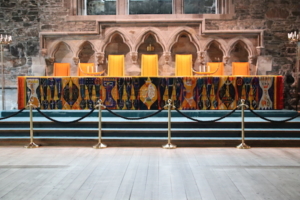
Above, the dais at one end of the expansive Haakon’s Hall, a space first built in the 13th century as part of a royal residence. The hall’s steep wooden ceiling.

We also climbed Rosenkrantz Tower (named for a 16th century governor of the fortress). More accurately, my companion climbed to the top, meaning to the roof and its views. I preferred skipping some of the work and spending more time viewing period displays in the rooms that one can access from the tower’s dark narrow stairwells.

Above, RosenkrantzTower, dating from the 13th century and now part of the Bergenhus Fortress. Below, one of several rooms accessible from the stairwell that takes visitors to the top of Rosenkrantz Tower. This one is called Erik’s Chamber, named for Erik Rosenkrantz, governor of Bergenhus Fortress in the 16th century. The table and chairs have nothing to do with Erik, but the bas-relief at the right is a copy of Erik and his wife’s tombstone.
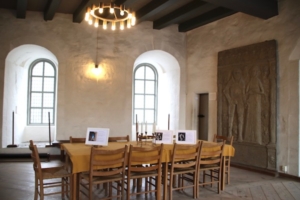
Seven mountains + a funicular
Bergen is called the city of seven mountains (forget seven hills), mountains that crowd against shorelines and dictate where it is possible to lay out streets and build homes.
We climbed for a short while into neighborhoods behind the Hanseatic League buildings to see samples of the city’s traditional small wooden houses and get an up-close look at their positioning on the steep hillsides.
For sweeping views, we rode the Floibanen Funicular to the top of Mount Floyen, 1.050 feet above sea level.
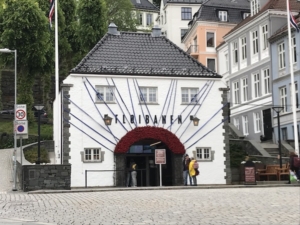
Above, entry for the Floibanen Funicular, which takes passengers to the top of Mount Floyen. Below, signpost at the top of Mount Floyen, highlighting Kyiv by using the colors of Ukraine’s flag.
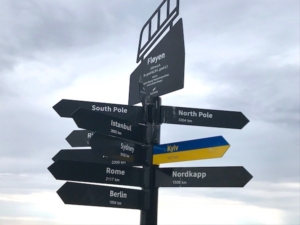
The funicular takes passengers to a viewing site with lots of options for taking a gander at the city, fjords and mountains — and a chance to watch tame goats tidy up the greenery around the lookout point. There also are a café and souvenir shop, plus the Floien Folkerestaurant. The latter was closed for renovations, but has a projected reopening date in April 2024.
The ambitious can hike to and from Floyen’s top.
Left unseen
We came to Bergen in part to position ourselves for a fjord cruise, departing on our second morning in town.
A short sojourn meant we left some things unseen, but I would never have left the Hanseatic Museum unvisited if it had been open. It is part of the UNESCO-protected site although down the street a couple of blocks. The museum’s annex, site of Hanseatic meeting rooms, is open, but the main attraction, a former Hanseatic house, is closed for major restoration work and projected to reopen in 2027. I visited the museum the first time I saw Bergen in 1991 and remember one thing: small sleeping spaces inside cupboards.

Above, in a 1991 photo, the centerpiece of the Hanseatic Museum, closed now for extensive renovations. Below, also from my 1991 visit, a Hanseatic Museum exhibit illustrating typical Bryggen sleeping arrangements, effectively inside wall cupboards.
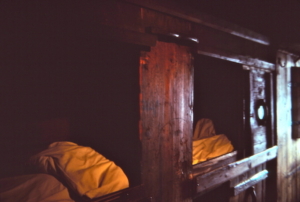
For those who may have more time in town, other attractions include the home of composer Edvard Grieg; the Old Bergen Museum, an open-air museum with some 55 wooden houses from the 18th to 20th centuries, and the wooden Fantoft Stave Church, first built in 1170.
About fires again: The stave church burned down in 1992, but this was no accident of fate. It was arson. Can you imagine? The reconstructed church, built with lumber from 350-to-400-year-old pines, was consecrated in 1997.

The Fantoft Stave Church, photographed under crappy skies in 1991, before an arson burned it the next year. It was carefully reconstructed in the same decade.

Above and below, more photos of Bergen Harbor, taken during my 1991 visit and posted just because I like them! The Rosenkrantz Tower is visible in the background of the top photo.
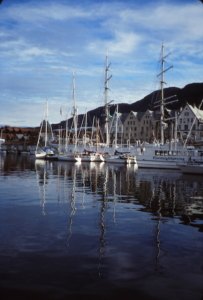
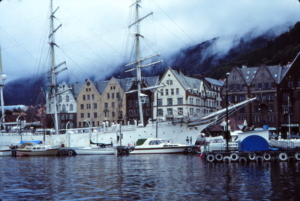
For more information about Norway, we offer at BestTripChoices.com the following, under the headline, Nobel country, https://besttripchoices.com/norway/
This blog and its photos are by Nadine Godwin, BestTripChoices.com editorial director and contributor to the trade newspaper, Travel Weekly. She also is the author of “Travia: The Ultimate Book of Travel Trivia.”
Bergen is a gateway to Norway’s famously beautiful fjords, including the longest and deepest, the Sognefjord, and it is home to the Bryggen UNESCO World Heritage Site.
